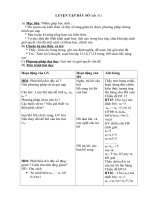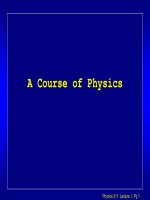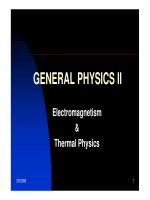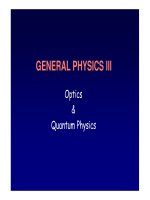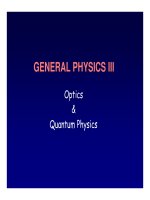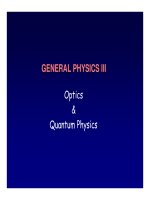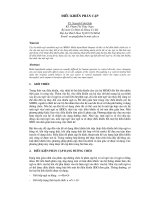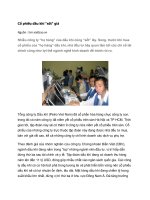- Trang chủ >>
- Khoa Học Tự Nhiên >>
- Vật lý
Tài liệu CHAPTER XI Electromagnetic Induction pptx
Bạn đang xem bản rút gọn của tài liệu. Xem và tải ngay bản đầy đủ của tài liệu tại đây (555.78 KB, 35 trang )
3/18/2008 1
GENERAL PHYSICS II
Electromagnetism
&
Thermal Physics
3/18/2008 2
CHAPTER XI
Electromagnetic Induction
§1. Induction experiment - Faraday’s and Lenz’s laws
§2. Induced electromotive force and induced electric fields
§3. Mutual inductance and self-inductance
§4. Magnetic field energy
3/18/2008 3
In the previous chapter we know that:
current magnetic field
In this chapter we will study currents produced by changing
magentic fields. In other words,
changing magnetic field current
3/18/2008 4
§1. Induction experiment - Faraday’s and Lenz’s laws:
1.1 Induction experiment:
Inside the shaded region, there is a
magnetic field into the board.
– If the loop is stationary, the
Lorentz force (on the electrons in
the wire) predicts:
(a) A Clockwise Current; (b) A Counterclockwise Current; (c) No Current
Now the loop is pulled to the right at a velocity v.
– The Lorentz force will now give rise to:
×
B
(a) A Clockwise Current
(b) A Counterclockwise Current
(c) No Current, due to Symmetry
×
B
v
3/18/2008 5
1831: Michael Faraday did the previous experiment, and a few others:
Move the magnet, not the loop. Here
there is no Lorentz force but
there was still an identical current.
(This phenomenon can be explained
by the relativity principle of motion).
v B
×
B
-v
I
×
B
Decreasing B↓
I
Decrease the strength of B. Now
nothing is moving, but M.F. still saw
a current:
dB
I
dt
3/18/2008 6
Instead of a magnet we use a loop
with current:
• Switch closed (or opened)
current induced in coil b
• Steady state current in coil a
no current induced in coil b
a
b
What is the cause of the currents induced in the loops in the
mentioned experiment?
Conclusion:
A current is induced in a loop when:
• there is a change in magnetic field through it
• this can happen many different ways
3/18/2008 7
1.2 Faraday’s law:
• Define the flux of the magnetic field through an open surface as:
The meaning of the integral in the r.h.s.: the total number of
magnetic lines through the surface.
Note that we must fix the choice of the surface’s normal vector.
Either choice is equally good, but once we make the choice we
must stick with it.
• Recall the analogous formula for the flux of the electric field
• Magnetic field lines is drawn by the same rule as electric field
lines)
dS
B
B
SdBΦ
B
3/18/2008 8
Faraday's law:
The emf
induced in a circuit is determined by the time rate
of change of the magnetic flux through that circuit.
dt
dΦ
ε
B
The minus sign indicates direction of induced current (given by
Lenz's Law).
A
B
(increasing)
A
B
(decreasing)
(+)
(+)
(+)
(+)
A A
B (increasing) B (decreasing)
ℰ
ℰ
ℰ
ℰ
3/18/2008 9
2.3 Lenz's Law:
• The direction of induced currents is determined by the Lenz's Law:
“The induced current will appear in such a direction that it
opposes the change in flux that produced it”.
Conservation of energy considerations:
Claim: Direction of induced current must be so as to oppose the
change; otherwise conservation of energy would be violated.
Why???
• If current reinforced the change, then the change would
get bigger and that would in turn induce a larger current
which would increase the change, etc..
v
B
S N
v
B
N
S
3/18/2008 10
Example 1:
A conducting rectangular loop moves with
constant velocity v in the +x direction
through a region of constant magnetic field
B in the -z direction as shown.
• What is the direction of the induced
current in the loop?
(a) ccw
(b) cw
(c) no induced current
X X X X X X X X X X X X
X X X X X X X X X X X X
X X X X X X X X X X X X
X X X X X X X X X X X X
v
x
y
There is a non-zero flux Φ
B
passing through the loop since B
is perpendicular to the area of the loop.
Since the velocity of the loop and the magnetic field are CONSTANT,
however, this flux DOES NOT CHANGE IN TIME.
Therefore, there is NO emf induced in the loop; NO current will flow!!
3/18/2008 11
A conducting rectangular loop
moves with constant velocity v in
the -y direction and a constant
current I flows in the +x direction
as shown.
What is the direction of the
induced current in the loop?
v
y
x
I
(a) ccw
(b) cw
(c) no induced current
Example 2:
The flux Φ
B
is decreasing → the induced current must create a
induced magnetic field which directs along the manetic field of the
current I
3/18/2008 12
Example on the calculation of induced current:
Suppose we pull with velocity v a coil of
resistance R through a region of constant
magnetic field B.
Direction of induced current?
v
w
x
I
What is the magnitude?
R
wBv
R
ε
I
B
Φ B Area Bwx
Magnetic Flux:
dx
Bw Bw v
dt
dt
dΦ
ε
B
Faraday’s Law:
x x x x x x
x x x x x x
x x x x x x
x x x x x x
Lenz’s Law clockwise!
We must supply a constant force to move the loop (until it is
completely out of the B-field region). The work we do is exactly
equal to the energy dissipated in the resistor, I
2
R (see
Appendix).
3/18/2008 13
§2. Induced electromotive force and induced electric fields:
2.1 Induced electric fields:
A magnetic field, increasing in time, passes through the blue loop
What force makes the charges move around the loop?
• It can’t be a magnetic force because the loop isn’t moving in a
magnetic field and even isn’t lying in a magnetic field
• The force exerting on charges exists in any case while the loop
is large or small, even while the loop does not have to be a wire.
We are forced to conclude that the curent is caused by a electric field
which is called induced electric field.
time
3/18/2008 14
Note: The wire isn’t the causion of induced emf, it is only the device which
help us observe the current, the emf exists even in vacuum, and this emf
is related to the induced electric field!
The equation for the induced electric field: The work done by the induced
electric field E per unit charge is equal to the induced emf, so we have
(the integration path is stationary)
Between the electrostatic and induced electric fields there are
radical differences:
• Recall that the electrostatic field is conservative (a work done by
the field depends only the intial and final positions; over a closed
path = 0). The induced electric field is nonconservative
→ For induced electric fields we can not introduce the concept
of potential.
• The electrostatic field is produced by a static charge distribution.
The induced electric field can not be produced by any static charge
distribution, it can be produced by a changing magnetic field.
